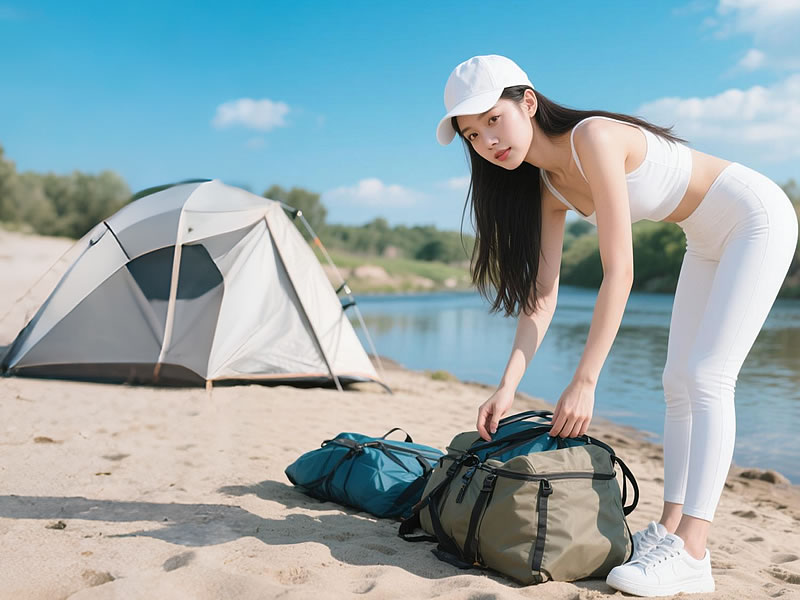How to pack lightweight gear efficiently?
Packing lightweight gear efficiently isn’t just about stuffing items into a backpack—it’s a strategic balance of weight distribution, accessibility, and space optimization. Whether you’re a thru-hiker or a weekend warrior, mastering these techniques can save energy, prevent injuries, and ensure you’re prepared for anything the trail throws at you.

Core Principles of Efficient Packing
1. Weight Distribution: Stability Over Speed
- Heavy Items Centered: Place dense gear (food, water, stove) near your back and between shoulder blades. This keeps your center of gravity balanced.
- Lightweight Items Below: Stuff sleeping bags or clothing at the bottom to create a stable base.
- Top-Load Essentials: Keep rain gear, first-aid kits, and snacks in the top lid for quick access.
Pro Tip: Use a kitchen scale to weigh each category (shelter, sleep, food) and balance them symmetrically.
2. Compression is Key
- Roll, Don’t Fold: Sleeping bags, quilts, and clothes compress smaller when rolled tightly.
- Compression Sacks: Sea to Summit Ultra-Sil sacks (1–2 oz) shrink bulky items by 30–50%.
- Vacuum Bags: For car camping, remove air from clothing bundles (not recommended for fragile gear).
Avoid: Over-compressing down sleeping bags—it damages loft over time.
3. Nesting and Multi-Use Items
- Cookware as Storage: Nest a stove, fuel canister, and lighter inside a pot.
- Clothes as Padding: Wrap fragile items (e.g., headlamps) in a puffy jacket.
- Stuff Sack Pillow: Fill an empty sack with spare clothes for camp comfort.
Step-by-Step Packing Guide
1. Prep Your Gear
- Lay Everything Out: Group items by category (shelter, sleep, cooking).
- Trim Non-Essentials: Cut duplicate tools, excess packaging, or redundant clothing.
2. Load Your Backpack
- Bottom Layer: Sleeping bag/quilt (in a waterproof sack).
- Mid Layer: Tent, sleeping pad, and clothing (rolled).
- Core Layer: Food canister, water reservoir, stove.
- Top Layer: Rain jacket, first-aid kit, map.
- External Attachments: Trekking poles, wet gear, or a tarp (use straps or bungees).
Pro Tip: Line your pack with a trash compactor bag for waterproofing.
5 Common Packing Mistakes to Avoid
- Ignoring Weather Forecasts: Packing a 3-season tent in a snowstorm or skipping rain gear.
- Overstuffing Side Pockets: Bulky side pockets throw off balance and snag on branches.
- Forgetting Accessibility: Burying your headlamp or filter at the bottom of the pack.
- Uneven Weight: A lopsided load causes muscle strain—weigh left/right compartments.
- Ignoring Pack Fit: Even perfect packing fails if the pack doesn’t match your torso length.
Tools to Maximize Efficiency
| Tool | Purpose | Weight |
|---|---|---|
| Compression Cubes | Organize clothes, reduce bulk | 1–3 oz |
| Ziplock Bags | Waterproof small items (matches, pills) | 0.1 oz |
| Pack Liner | Trash compactor bag (100% waterproof) | 2 oz |
| Carabiner Clips | Attach shoes, water bottles | 0.5 oz |
Ultralight vs. Traditional Packing
| Category | Ultralight Approach | Traditional Approach |
|---|---|---|
| Sleep System | Quilt + inflatable pad (2 lbs) | Sleeping bag + foam pad (4 lbs) |
| Shelter | Tarp + trekking poles (1.5 lbs) | Freestanding tent (5 lbs) |
| Water | 1L bottle + filter (8 oz) | 3L reservoir + pump (1.5 lbs) |
Pro Tips for Last-Minute Optimization
- Test Your Pack: Walk around your home with a loaded pack to check balance.
- Color-Code Bags: Use red for emergency gear, blue for clothes, etc.
- Repurpose Gear: A bandana becomes a towel, pot holder, or sunshield.
SEO-Optimized Takeaways
- Keywords: Integrate terms like “ultralight packing tips,” “backpack organization,” or “lightweight gear compression” naturally.
- User Intent: Answer FAQs like “How to pack a backpack for backpacking?” or “What’s the lightest way to carry gear?”
- Readability: Use bullet points, tables, and bold headers for easy scanning.
Final Thoughts
Efficient packing transforms hiking from a chore into a joy. By prioritizing weight distribution, compressing smartly, and eliminating redundancies, you’ll move faster, feel fresher, and savor the journey. Remember: Every gram saved is a step toward longer trails and bigger adventures. Test your system, tweak as needed, and let the mountains—not your pack—be the challenge.






